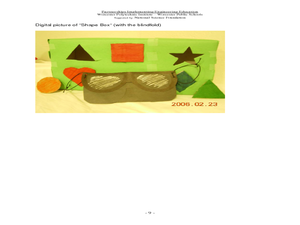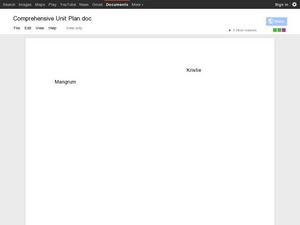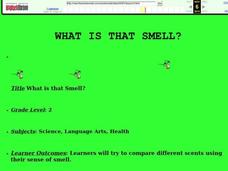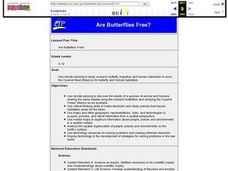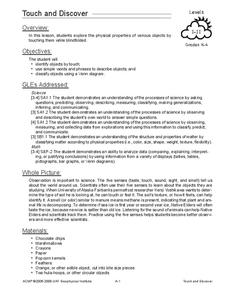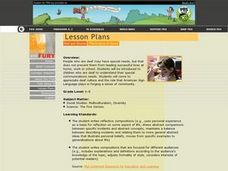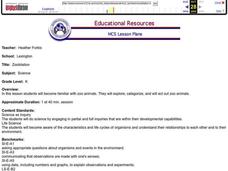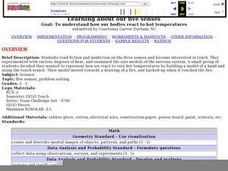Washington Office of Superintendent of Public Instruction
Using Our Senses to Observe
Look around and explore. Little ones use their five senses with some day-to-day activities designed to guide observation and apply STEM strategies. Young scientists learn through comparing/contrasting and...
Curated OER
Ecosystems and Remote Sensing
Young scholars obtain remote sensing data to compare and contrast global biomass data with global temperature data.
Curated OER
Mealworms
Crawl into the world of the darkling beetle with this scientific investigation. Watch as the insects move through the larval, pupal, and adult stages of life, recording observations along the way. Discuss the necessities of life as young...
Curated OER
Recognizing the Importance of Sight
Learners discover the true value of their senses. In this sight lesson plan, students discover the difficulty of life without sight by performing everyday activities without the help of their eyes. The learners examine their results and...
Curated OER
The Life Cycle of the Mealworm
Fourth graders provide a habitat for live mealworms and observe their life cycle. In this animal life cycle and scientific inquiry activity, 4th graders create a habitat for a live mealworm and observe and record related data as it...
Curated OER
My Wet Robot
After hearing about the 2006 PHAEDRA mission that explored the Aegean Sea, middle schoolers work in groups to create a robotic vehicle. They must consider power, propulsion, and other vital systems. Use the multitude of external...
Curated OER
What is That Smell?
Students identify various scents by using their sense of smell. In this five senses lesson, students smell items such as popcorn, mint, and lemon and identify the scents by only using their sense of smell.
Curated OER
Life Cycles
Using computers, Students work in small groups and progress through the roles of Explorer, Researcher, Designer, and Evaluator as they study the life cycle of plants, insects, butterflies and frogs.
Curated OER
Investigate Science Using Crayfish
Young scientists discover the importance of scientific investigation by observing live crayfish. They carefully observe the patterns of crayfish in different environments. Then they discuss their conclusions and define what all living...
Curated OER
Where Am I?
Extensive background on marine navigation is provided for you as the teacher. Assign groups to research marine navigation techniques and construct astrolabes. Resource links are listed for extension ideas. If you are teaching an...
Curated OER
Math for the Frontier
Make history come to life by using the Frontier House series to engage students in the past. Your class will "prepare" for a trip to 1833 Montana. They will learn about homesteading, frontier life, inflation, and cost of living. Using...
Curated OER
Five Senses: Brave Little Monster
Students identify which of the five senses is being used at a given time. They read "Brave Little Monster" by Ken Baker and then read the story again as they match student-made cards depicting the five senses to moments in the story.
Curated OER
The Very Hungry Caterpillar
Here is a good lesson on butterflies and caterpillars. After listening to The Very Hungry Caterpillar, young learners put cards that depict the life cycle of a butterfly in the correct order. There are some good ideas for center...
Curated OER
Are Butterflies Free?
Students use remote sensing to study monarch butterfly migration and human interaction to save the Oyamel forest (Mexico) for butterfly and human habitation.
Curated OER
Touch and Discover
Young scholars identify the physical properties of items using the sense of touch. In this touch and discover lesson, students describe items. Young scholars sort items using a Venn diagram.
Curated OER
Deaf and Diverse
Students examine deaf culture and the role that American Sign Language plays in forging a sense of community.
Curated OER
Energy Generating a Culture: Early American Coal Miners and Coal Mining Culture
Young scholars calculate how much coal they use based on their electric power usage. In this environmental science lesson, students trace the history of coal mining in US. They write a letter to USPS to encourage them to create coal...
Curated OER
Dolphins
Students explore sea life. In this cross curriculum fine arts, science, and P.E. "dolphins" activity, students sing songs and play games about dolphins, perform water experiments, create mosaics, and use their five senses to explore sand...
Curated OER
Zoobilation
Youngsters become familiar with zoo animals. They sort them into categories, and choose an animal to act out. Two zoo centers are created in the classroom that have examples of the animals for the pupils to play with. Then, they choose...
Curated OER
Learning About Our Five Senses
Students study the sense of touch and various degrees of heat. They design a model that displays how the human hand reacts to heat using a touch sensor.
Curated OER
The Sense of Hearing
High schoolers study the cycle of how we listen and hear our own speech. They examine sound waves, and the role of the nervous system in hearing. They investigate the cues besides lipreading that deaf people rely on for comprehension.
Space Awareness
Oceans on the Rise
Temperature rises and land disappears! Through a lab exploration, learners understand the effect of temperature increase on water similar to the effect of global warming on our oceans. As they heat the water in a flask, they measure the...
Curated OER
Tide Pool Discovery
First graders visit the Discovery Pool, where they use their senses to investigate the different tide pool species. They touch different species. Students describe how each one feels, and what they look like in words. They draw the...
Curated OER
Vegetable Twister
Second graders study the changes in organisms over time. In this Life Science lesson plan, 2nd graders explore how living things react to changes in the environment. Students identify the basic needs of living things.



